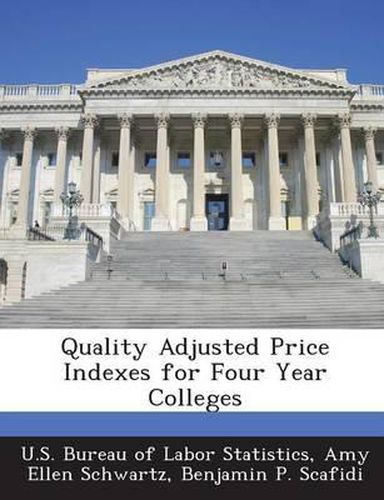Readings Newsletter
Become a Readings Member to make your shopping experience even easier.
Sign in or sign up for free!
You’re not far away from qualifying for FREE standard shipping within Australia
You’ve qualified for FREE standard shipping within Australia
The cart is loading…






Since the earlier 1980’s the “sticker price” of a college education in the United States has, according to estimates from the Consumer Price Index (CPI), risen significantly faster than the overall rate of inflation. For the CPI, the government collects data on the “sticker price” of college (tuition and fees) without adjusting for scholarships given or other discounts. Further, no adjustments are made for changes in the quality or characteristics of the services provided, such as attributes of the faculty, the course offerings, or the facilities. Thus, the estimated price indices reflect changes in quality and characteristics of college as well as changes in prices. In this paper, we develop and explore the construction of a quality-adjusted price index for US colleges, based on the estimation of a hedonic model of the price of college. Our analysis indicates that estimating price indexes using hedonic methods is both feasible and useful. Four particular recommendations emerge from this research. First, the price of college should be measured as the ‘net’ (tuition and fees net of financial aid) rather than the ‘sticker’ price for computing a consumer price index. Price indexes computed based upon tuition plus fees net of financial aid indicate significantly lower price rises than the price indexes computed based only upon tuition plus fees. Second, our results indicate that the ‘brand’ effect of individual colleges is important, so that price indexes should be computed controlling for the college-fixed effect. Third, it is important to include the attributes of colleges in constructing the price index in order to control for changes in the quality of college. And fourth, colleges that have graduate schools demonstrate different pricing than colleges that do not. While the conceptual framework for implementing a quality-adjusted price index for higher education is straightforward, practical implementation with currently available data presents empirical challenges
$9.00 standard shipping within Australia
FREE standard shipping within Australia for orders over $100.00
Express & International shipping calculated at checkout
Since the earlier 1980’s the “sticker price” of a college education in the United States has, according to estimates from the Consumer Price Index (CPI), risen significantly faster than the overall rate of inflation. For the CPI, the government collects data on the “sticker price” of college (tuition and fees) without adjusting for scholarships given or other discounts. Further, no adjustments are made for changes in the quality or characteristics of the services provided, such as attributes of the faculty, the course offerings, or the facilities. Thus, the estimated price indices reflect changes in quality and characteristics of college as well as changes in prices. In this paper, we develop and explore the construction of a quality-adjusted price index for US colleges, based on the estimation of a hedonic model of the price of college. Our analysis indicates that estimating price indexes using hedonic methods is both feasible and useful. Four particular recommendations emerge from this research. First, the price of college should be measured as the ‘net’ (tuition and fees net of financial aid) rather than the ‘sticker’ price for computing a consumer price index. Price indexes computed based upon tuition plus fees net of financial aid indicate significantly lower price rises than the price indexes computed based only upon tuition plus fees. Second, our results indicate that the ‘brand’ effect of individual colleges is important, so that price indexes should be computed controlling for the college-fixed effect. Third, it is important to include the attributes of colleges in constructing the price index in order to control for changes in the quality of college. And fourth, colleges that have graduate schools demonstrate different pricing than colleges that do not. While the conceptual framework for implementing a quality-adjusted price index for higher education is straightforward, practical implementation with currently available data presents empirical challenges